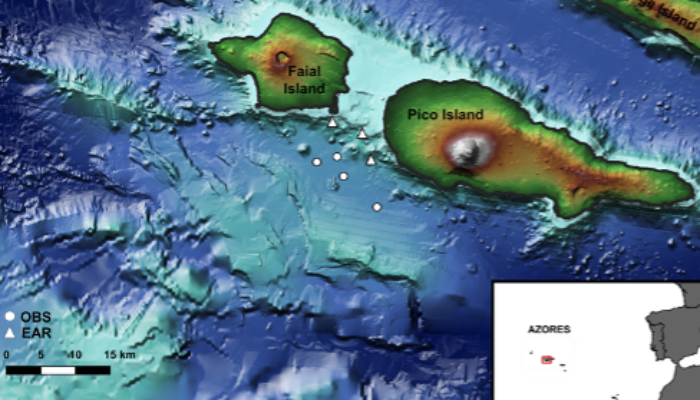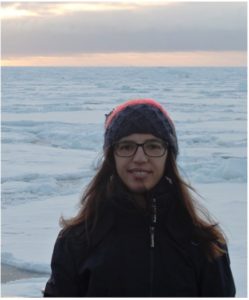
“SENSOR” – stands for Seismological Experiments, Network Systems, Observations and Recovery
In this blog series, we share news about recent or upcoming seismic experiments around the globe!
The first blog of the SENSOR series follows a young researcher, Dr. Andreia Pereira, from the Instituto Dom Luiz of the University of Lisbon, who is working on the AWARENESS project and has explained to me the aims of this exciting research project. The team she is working in has been awarded funding from the Fundação para a Ciência e a Tecnologia (FCT) – the Portuguese national funding agency for science, research and technology – to install a seismic array around the Azores and study the ‘voice’ of the whales. But just read below what Andreia shares with us!
“Our project is called AWARENESS – Assessing vocal behaviour of fin whales for robust density estimation from passive acoustics. It started in October 2018, and it will end in October 2021 and includes researchers from Faculdade de Ciências da Universidade de Lisboa (FCUL) and the Institute of Marine Research (IMAR) of the University of Azores. We are a multidisciplinary team composed of geophysicists, some of whom specialized in developing OBSs (ocean bottom seismometer), and biologists who study fin whales using different types of data such as visual, acoustics and satellite tags. Our study area is around the Azores waters (Figure 1), which are part of a migratory corridor of fin (Figure 2), that extends between low latitude and high latitude areas. This species is present in the Azores waters year-round, but they suspend their journeys northwards and stay around the Azores to feed between spring and summer.”
“Our team deployed four short-period OBSs between March and September 2019 (Figure 1). Each OBS (Figure 3) recorded two sensors distributed in four channels with a 200 Hz sampling rate: a three-component seismometer SM 6-4.5Hz and a hydrophone HTI-01-PCA/ULF. The sampling rate provided a usable frequency up to ~75 Hz. In addition to the OBSs, the team also deployed four EARs, Ecological Acoustical Recorders, which usually record high-frequency biological sounds. Since EARs have a higher sampling rate, they could not record full days for extended periods, as OBSs could. Due to battery life and disk space limitations, EARs were programmed to record 6 hours each day, starting at 08:00:00 and ending at 14:00:00.”
“EARs provided an extended frequency range that allowed the identification of some biological signals that were recorded by the OBSs but were cut because of the low sampling rate, such as the highly recognizable humpback whales songs (that were not so recognizable in the OBS recordings).”

Figure 4 | Spectrogram of 6 minutes of recordings in one EAR (top) and one OBS (bottom), showing the recording of parts of a humpback whale song. It was possible to match some of the low-frequency sounds (white rectangles) in the two spectrograms.
“Fin whales are classified as ‘vulnerable’ species by the International Union for Conservation of Nature owing to extensive overexploitation from commercial whaling during the 19th and 20th centuries. In addition to climate change, fin whales are subjected to a novel mix of anthropogenic pressures, including entanglement in fishing gears, ship strikes, exposure to noise, and various pollutants. Maintaining healthy populations of fin whales requires gathering information about population size and temporal and spatial patterns of occurrence. However, traditional approaches (based on visual data) to monitor this species are difficult because they range widely across oceans, they spend considerable time underwater, and daylight, weather, and ocean conditions limit visual census. Fin whales produce long patterned sequences, also known as songs, of high intensity, low-frequency sounds (<1kHz) that can travel great distances. These characteristics make them highly amenable for acoustic monitoring with OBS data. OBSs have been successfully used to (1) detect the presence of several baleen whale species, (2) assess temporal variability in song patterns that could be linked to population structure, (3) track movements of recorded individuals, (4) estimate animal density, and (5) measure sound source levels of whales. These studies show the high potential of OBS data in monitoring fin whales. Some fin whale sounds seem to be produced only by males (like the most common, the “20-Hz note”; Figure 5), but other sounds could also be used for acoustic monitoring of all segments of the populations. The production context of these other sounds is not well known as the most common sounds, and therefore it is necessary to assess their production and temporal patterns. Our project aims to investigate temporal patterns in the vocal activity of fin whales and identify new sounds suitable for monitoring purposes of the species.”

Figure 5 | Spectrogram of 6 minutes of recordings in one OBS showing two types of fin whale signals, the 20-Hz note and the backbeat (the lower frequency signal).
“Although our project aims to study fin whales, we are also finding exciting low-frequency signals that might have a biological source. In the OBS recovery process, we found clues of the interaction of animals with the OBS, such as bite marks and teeth. We also found animals inside the instruments!”
“Usually, fishes produce higher frequency signals, but since deep-sea fishes live in a pitch-black environment characterised by extreme pressure (which results in higher sound velocity), they might have evolved to use low frequency sounds to re-connect and communicate. Since we could not match a species to our recordings of unknown low-frequency signals, it is still a mystery!”
“We have another project planned, but we will need extra funds. In our future project, we plan to use OBS datasets from several areas of the world (so we can have different deployment areas and propagation conditions) to test different location and animal density methods. We would like to develop signal processing tools, ranging methods and animal abundance methods to be applied to the OBS data so that different researchers and stakeholders could use OBS data for animal monitoring and conservation efforts in different areas of the world.”
That’s very exciting! And let’s hope Andreia and the rest of the team could start this project soon!
You can check out the project website, but it’s in Portuguese at this moment, English version is coming up soon!




